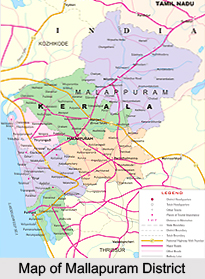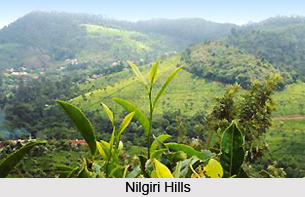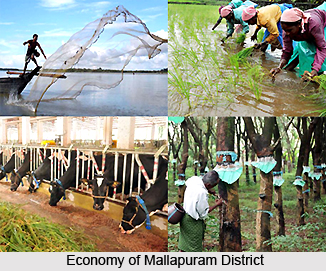 Mallapuram district was born on 16th June 1969. It is situated on the Calicut - Madras road that is at 12 km. southwest of Manjeri and 52 km. southwest of Calicut. Mallapuram is the head quarters of the district. In earlier times, Mallapuram was the headquarters of European and British troops and later it became the headquarters of the Malabar Special Police, which is known, as abbreviation is M.S.P.
Mallapuram district was born on 16th June 1969. It is situated on the Calicut - Madras road that is at 12 km. southwest of Manjeri and 52 km. southwest of Calicut. Mallapuram is the head quarters of the district. In earlier times, Mallapuram was the headquarters of European and British troops and later it became the headquarters of the Malabar Special Police, which is known, as abbreviation is M.S.P.
This place has still the ruins of an ancient fort built by Tipu Sultan. Mallapuram was also the scene of the Malabar rebellion of 1921, which was suppressed by the Malabar Special Police. In 1957 and 1969 large-scale changes in the territorial jurisdiction of this tract took place. On 1st January 1957, Tirur taluk was newly formed taking portions of Ernad and Ponnani taluks. Another portion of Ponnani taluk was transferred to the newly formed Chavakkad taluk, while the residuary portion was known as Ponnani taluk.
Perinthalmanna was a new taluk formed out of the former Valluvanad taluk. Of these, Ernad and Tirur continued under Kozhikode district and Perinthalmanna as well as Ponnani under the Palakkad district. The new district of Mallapuram was formed with four taluks, Ernad, Perinthalmanna, Tirur and Ponnani, four statutory towns, fourteen developmental blocks and ninety-five panchayats. Two more taluks namely Tirurangadi and Nilambur were formed later by diverging Tirur and Ernad taluk.
At present Mallapuram District consists of 2 Revenue Divisions, 6 Taluks, 135 Villages, 14 blocks, 5 Muncipalities and 100 panchayats.
Geography of Mallapuram District, Kerala
Mallapuram is a hilly terraced region. The innumerable streams that wander these hills reach the coconut fringed and picturesque seacoast.There is an International Airport at Karipur in MALAPURAM (25 Km from city).
District profile:
Malappuram, the literal meaning of which is a land a tops hills. It is situated 50 kms southeast of Kozhikode, bounded by the Nilgiri Hills in the east, the Arabian Sea in the west and Thrissur and Palakkad districts in the south. Three great rivers flowing through it, namely the Chaliyar, the Kadalundi and the Bharathappuzha, enrich Malappuram.
Malappuram has a rich and exciting history. Since ancient time it was the military headquarters of the Zamorins of Kozhikode. Between 1792 and 1921 many of the Mappila revolts or conflicts against the British East India Company in Kerala took place in this district. It was a famous centre for Hindu, Vedic learning and Islamic philosophy and a place of cultural heritage.
The area of the districts is 3350 sq km. The altitude of the district is mainly lowland that means it is in sea level. Its highlands are at 477-2340 m above the sea level. The total population of the district is 3,629,640 out of which 1,759,479 are male and 1,870,161 are females. The sex ratio is 1063 female per 1000 male while population density is 1022.
The temples and mosques of this district are well known for their spectacular festivals. This place is worth visiting because of many factors as for examples historic moments and diverse natural attractions, a range of cultural and ritual art forms, etc.
Different departments of Mallapuram district is as follows:
 Revenue: Mallapuram district is consisting of two Revenue Divisions, six Taluks, and 135 villages. Some of the important functions of revenue department are revenue recovery, building tax, assignment of Government Land, assignment of surplus land, lease, citizenship registration, explosive license and magisterial powers, election, etc.
Revenue: Mallapuram district is consisting of two Revenue Divisions, six Taluks, and 135 villages. Some of the important functions of revenue department are revenue recovery, building tax, assignment of Government Land, assignment of surplus land, lease, citizenship registration, explosive license and magisterial powers, election, etc.
Agricultural activities: The Agriculture Department in Malappuram District is taking sincere effort for carving out a dynamic and vibrant agriculture sector. This is responsive to the needs of local farming community.India`s first food technology park is at Kakkancherry in Mallapuram.
The role and responsibility of Krishi Bhavan and the basic contact point of the farming community is very significant in planning, formulation and execution of viable and need based programme. Krishi Bhavan also acts as an effective transfer of technology agents in the agricultural sector. The following are some of the important schemes implemented by the department: State sector scheme for rice and paddy, Central sector scheme for coconut, intensive vegetable development programme, etc.
Fisheries: The Mallapuram district has 70 km of seacoast. It extends from Kadalundi Nagaram in the north to Palappetty in the South. The coastal belt is in many places. The main fishing centers are at Ponnani, Koottayi, Parappanangadi, and Tanur. Out of these centers Ponnani is a major fisheries port with about 350 mechanized boats. High sea fish catching operations are centered in Ponnani and Parappanangadi. There are Fisheries guide lights, at Ponnani and Tanur to help night fishing.
There are various schemes to provide fishing equipments, houses, latrines and other amenities to fishermen. There are also educational assistance schemes, financial assistance for the benefits of fishermen during off-season. A Fish Farmer Development Agency or FFDA is there to promote inland fishing.
Animal husbandry: The functioning of Animal Husbandry can be classified into 7 groups. Viz. artificial insemination, treatment facilities, remedial measures for resisting diseases, schemes, production centers, is some of them.
Health services: A good network of health care units are functioning under the Government Sector. Modern medicines, Ayurveda and Homeopathy services are also available.
Co-operatives: The district has a good network of Co-Operative societies. All types of Co-operative activities ranging from ration shops to hospitals are undertaken under Co-operatives.
Scheduled caste development: The District has a scheduled caste population of 25,573. Some of the main communities are Pulaya, Paraya, Kanakka Panan, Mannaan, Perumannaan, Kalladi, Cheruma etc. In some of the developmental programmes Education is given priority for the Scheduled Castes.
The scheduled caste development department undertake various social welfare measures like house construction, providing land and house to the landless and houseless people, thatching and filling grants, sanitation latrine construction, lump sum grant and stipend to SC students, etc. This department also gives educational Assistance to Other Backward Communities, Other Eligible Communities, and financially backward students of forward communities.
National informatics center: The organizational structure of NIC comprehends its Headquarters at Delhi; Regional centre at Pune, Bhubaneshwar and Hyderabad; State units in all the state Capitals and Union Territory Headquarters; and Offices in over all Districts of the country, respectively.
Transportation of Mallapuram District:
Mallapuram is connected to different cities with its many possible means and there are 4 Head Post Offices, 141 Sub Post Offices, and 287 extra department branch post offices. The two Postal Divisions are situated at Manjeri & Tirur respectively.
 Mass communication:
Mass communication:
Malayala Manorama published from Malappuram, Mathrubhumi published from Kottakkal and Madyamam published from Perinthalmanna are the three newspapers published from the district. The evening daily Prehalika, is published from Tirur. A few periodicals, monthlies, fortnightlies and weeklies, which are devoted to this religion and culture, are also published. Since 1981 a capsule cultural monthly magazine Innu is being published from Malappuram. All the important daily newspapers published from other districts, have wide circulation in Malappuram district.
Education:
The Mallapuram district has achieved tremendous progress in the filed of education during the last decade. Great development has been made in the field of female education. There are various numbers of schools, colleges, B.Ed centers, polytechniques, teaching training institute, engineering colleges, oriental title colleges, etc present in this district. The Calicut University present in Tenhippalam in Malappuram district was established in 1968.Malapuram is India`s first fully e-literate district.World`s only teak meuseum is at Nilambur in Mallapuram.






